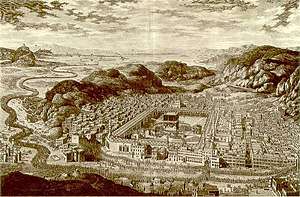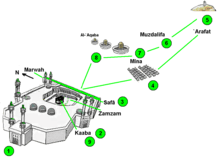Great Mosque of Mecca
| Al-Haram Mosque | |
|---|---|
| Arabic: ٱلْـمَـسْـجِـد الْـحَـرَام, translit. Al-Masjid al-Ḥarām | |
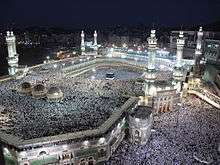 The Grand Mosque during the Hajj of 2009 | |
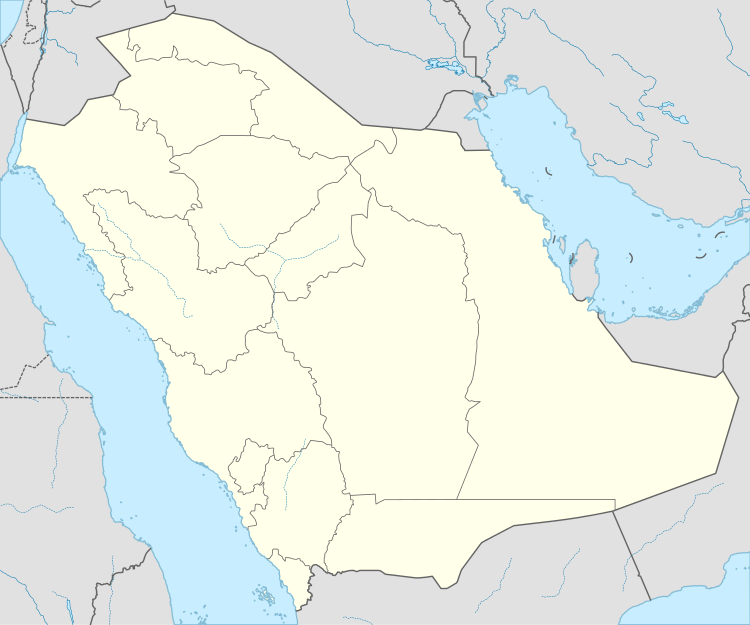 Location in Saudi Arabia | |
| Basic information | |
| Location | Makkah, Hejaz, Saudi Arabia[1] |
| Geographic coordinates | 21°25′19″N 39°49′34″E / 21.422°N 39.826°ECoordinates: 21°25′19″N 39°49′34″E / 21.422°N 39.826°E |
| Affiliation | Islam |
| Administration | Saudi Arabian government |
| Leadership |
Imam(s): Abdul Rahman Al-Sudais Saud Al-Shuraim Abdullah Awad Al Juhany Saleh Al Talib Saleh Al Humaid Bandar Baleelah Usaamah Khayyat Yaseer Al Dosari Khalid Al Ghmadi Maher Al Muaiqly Faisal Gazzawi[2][3] |
| Website |
www |
| Architectural description | |
| Architectural type | Mosque |
| Date established | Era of Abraham in Islamic thought[4] |
| Specifications | |
| Capacity | 900,000 worshippers (Increased to 4,000,000 worshippers during the Hajj period) |
| Length | 400.800 m |
| Minaret(s) | 9 |
| Minaret height | 89 m (292 ft) |
| Part of a series on |
| Islam |
|---|
 |
|
The Great Mosque of Makkah, also called Al-Haram Mosque (Arabic: ٱلْـمَـسْـجِـد الْـحَـرَام, translit. al-Masjid al-Ḥarām, "the Sacred Mosque"[5] or "the Sacred Mosque"[6]:471) or Grand Mosque of Makkah,[7] is the largest mosque in the world, and surrounds the Islamic Qiblah (Arabic: قِـبْـلَـة, Direction of Prayer), that is the Kaaba in the Hejazi[8] city of Makkah (Arabic: مَـكَّـة, Makkah), Saudi Arabia. Muslims face the Kaaba while performing the Ṣalāh (Arabic: صَـلَاة, Islamic act of worship). One of the Five Pillars of Islam requires every Muslim to perform the Ḥajj (Arabic: حَـجّ, 'Pilgrimage'), one of the largest annual gatherings of people in the world, at least once in their lifetime if able to do so, including Ṭawāf (Arabic: طَـوَاف, Circumambulation) of the Kaaba. It is also the main phase for the ‘Umrah (Arabic: عُـمْـرَة), which is the lesser pilgrimage that can be undertaken any time of the year. The Grand Mosque includes other important significant sites, including the Black Stone, Well of Zamzam, Station of Abraham, and Safa and Marwa. It is always open, regardless of date or time. It has gone under major renovations by various caliphs, sultans and kings, and it is now under the control of the Custodian of the Two Holy Mosques.[9] It is in front of the tallest clock tower and fourth tallest structure in the world, the Abraj Al Bait,[10] the construction of which has been surrounded by controversy concerning the destruction of early Islamic heritage sites by the Saudi government.[11]
History
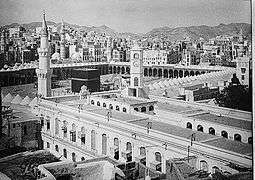
Al-Haram Mosque rivals the Mosque of the Companions in the Eritrea city of Massawa[12] and Quba Mosque in Medina as the first stated mosque.[13]
Era of Abraham and Ishmael
The Quran [2:127][14] states that Ibrahīm (Arabic: إِبْـرَاهِـيْـم, Abraham), together with his son Ismāʿīl (Arabic: إِسْـمَـاعِـيْـل, Ishmael), raised the foundations of a house that is identified by most commentators as the Kaaba. God had shown Abraham the exact site, very near to the Well of Zamzam, where Abraham and Ishmael began work on the Kaaba's construction in circa 2130 BCE. After Abraham had built the Kaaba, an angel brought to him the Black Stone, a celestial stone that, according to tradition, had fallen from Heaven on the nearby hill Abu Qubays. According to a saying attributed to Muhammad, the Black Stone had "descended from Paradise whiter than milk but the sins of the sons of Adam had made it dark". The Black Stone is believed to be the only remnant of the original structure made by Abraham.
After placing the Black Stone in the Eastern corner of the Kaaba, Abraham received a revelation, in which God told the aged prophet that he should now go and proclaim the pilgrimage to mankind, so that men may come both from Arabia and from lands far away, on camel and on foot.[15]
Era of Muhammad
Upon Muhammad's victorious return to Mecca in 630 CE, he and his son-in-law, Ali Ibn Abi Talib, broke the idols in and around the Kaaba, similar to what, according to the Quran, Abraham did in his homeland.[16][lower-alpha 1] Thus ended polytheistic use of the Kaaba, and re-began monotheistic rule over it and its sanctuary.[20][21][22][23]
Umayyad era
The first major renovation to the mosque took place in 692 on the orders of Abd al-Malik ibn Marwan.[24] Before this renovation, which included the mosque's outer walls being raised and decoration added to the ceiling, the mosque was a small open area with the Kaaba at the center. By the end of the 8th century, the mosque's old wooden columns had been replaced with marble columns and the wings of the prayer hall had been extended on both sides along with the addition of a minaret on the orders of Al-Walid I.[25][26] The spread of Islam in the Middle East and the influx of pilgrims required an almost complete rebuilding of the site which included adding more marble and three more minarets.
Ottoman era
In 1570, Sultan Selim II commissioned the chief architect Mimar Sinan to renovate the mosque. This renovation resulted in the replacement of the flat roof with domes decorated with calligraphy internally, and the placement of new support columns which are acknowledged as the earliest architectural features of the present mosque. These features are the oldest surviving parts of the building.
During heavy rains and flash floods in 1621 and 1629, the walls of the Kaaba and the mosque suffered extensive damage.[27] In 1629, during the reign of Sultan Murad IV, the mosque was renovated. In the renovation of the mosque, a new stone arcade was added, three more minarets (bringing the total to seven) were built, and the marble flooring was retiled. This was the unaltered state of the mosque for nearly three centuries.
Saudi era
The first major renovation under the Saudi kings was done between 1955 and 1973. In this renovation, four more minarets were added, the ceiling was refurnished, and the floor was replaced with artificial stone and marble. The Mas'a gallery (As-Safa and Al-Marwah) is included in the Mosque, via roofing and enclosures. During this renovation many of the historical features built by the Ottomans, particularly the support columns, were demolished.
On 20 November 1979, the Great Mosque was seized by extremist insurgents who called for the overthrow of the Saudi dynasty. They took hostages and in the ensuing siege hundreds were killed. These events came as a shock to the Islamic world, as violence is strictly forbidden within the mosque.
The second Saudi renovations under King Fahd, added a new wing and an outdoor prayer area to the mosque. The new wing, which is also for prayers, is reached through the King Fahd Gate. This extension was performed between 1982 and 1988.[28]
The third Saudi extension (1988–2005) saw the building of more minarets, the erecting of a King's residence overlooking the mosque and more prayer area in and around the mosque itself. These developments have taken place simultaneously with those in Arafat, Mina and Muzdalifah. This third extension has also resulted in 18 more gates, three domes corresponding in position to each gate and the installation of nearly 500 marble columns. Other modern developments include the addition of heated floors, air conditioning, escalators and a drainage system.
Current expansion project
In 2007, the mosque commenced a fourth extension project which is estimated to last until 2020. King Abdullah Ibn Abdulaziz planned to increase the mosque's capacity to 2 million; although the King died in 2015, his successor, King Salman, is likely to continue renovations.[7][29] In 2016 it was estimated that Great Mosque had cost 100 billion dollars.[30]
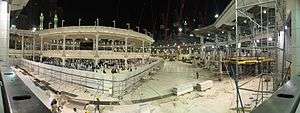
Northern expansion of the mosque began in August 2011 and was expected to be completed in one and a half years. The area of the mosque will be expanded from the current 356,000 m2 (3,830,000 sq ft) to 400,000 m2 (4,300,000 sq ft). A new gate named after King Abdullah will be built together with two new minarets, bringing their total to eleven. The cost of the project is $10.6 billion and after completion the mosque will house over 2.5 million worshipers. The Mataaf (the circumambulation areas around the Kaaba) will also see expansion and all closed spaces will be air conditioned.[31] The King Abdullah Expansion Project will cover an area of 456,000 sq. meters will accommodate an additional 1.2 million faithful. Courtyards of the mosque’s new expansion can hold more than 250,000 worshipers. The project is being implemented by the Saudi Binladin Group.[32]
On 11 September 2015, at least 111 people died and 394 were injured when a crane collapsed onto the mosque.[33][34][35][36][37][38]
List of former Imams and Mu'adhins
Imams:[39]
- Abdullah Al-Khulaifi (Arabic: عَـبْـد ٱلله الْـخُـلَـيْـفِي)
- Ahmad Khatib (Arabic: أَحْـمَـد خَـطِـيْـب), Islamic Scholar from Indonesia
- Ali bin Abdullah Jaber (Arabic: عَـلِى بِـن عَـبْـدُ ٱلله جَـابِـر), Maliki Jurist of Mecca
- Umar Al-Subayyil (Arabic: عُـمَـر الـسُّـبَـيِّـل), active member of Khatame-Nabbuwwat Organisation
- Muhammad Al-Subayyil (Arabic: مُـحَـمَّـد الـسُّـبَـيِّـل), died in 2013
- Abdullah Al-Harazi (Arabic: عَـبْـد ٱلله الْـحَـرَازِي), former Chairman of Saudi Majlis al-Shura
- Ali bin Abdur-Rahman Al-Huthaify (Arabic: عَـلِي بِـن عَـبْـدُ ٱلـرَّحۡـمٰـن الْـحُـذَيْـفِي), now Chief Imam of al-Masjid an-Nabawi, and member of Saudi Arabia's Al-Hilaal Committee
- Salah ibn Muhammad Al-Budair (Arabic: صَـلَاح ابْـن مُـحَـمَّـد الْـبُـدَيْـر), now Deputy Chief Imam of al-Masjid an-Nabawi
- Adil al-Kalbani[40] (Arabic: عَـادِل الْـكَـلْـبَـانِي)
Pilgrimage
The Great Mosque is the main setting for the Hajj and Umrah pilgrimages[42] that occur in the month of Dhu al-Hijjah in the Islamic calendar and at any time of the year, respectively. The Hajj pilgrimage is one of the Pillars of Islam, required of all able-bodied Muslims who can afford the trip. In recent times, over 5 million Muslims perform the Hajj every year.[43]
Some of the rituals performed by pilgrims are symbolic of historical incidents. For example, the episode of Hagar's search for water is emulated by Muslims as they run between the two hills of Safa and Marwah. The Hajj is associated with the life of the Islamic prophet Muhammad from the 7th century, but the ritual of pilgrimage to Mecca is considered by Muslims to stretch back thousands of years to the time of Ibrahim (Abraham).
Symbolic structures
Kaaba
Al-Ka‘bah (Arabic: اَلْـكَـعْـبَـة, "The Cube") is a cuboid-shaped building in the center of the Great Mosque and is one of the most sacred sites in Islam.[44] All Muslims around the world face the Kaaba during prayers, no matter where they are. The direction from the location of the person who prays to the Kaaba is called the Qibla.
The Hajj requires pilgrims to circumambulate seven times around the Kaaba in a counter-clockwise direction. This circumambulation, the Tawaaf, is also performed by pilgrims during the Umrah (lesser pilgrimage).[44][45][46]
Black Stone
The Black Stone (Arabic: اَلْـحَـجَـر الْأَسْـوَد al-Ḥajar al-Aswad) is the eastern cornerstone of the Kaaba.[47] It was set intact into the Kaaba's wall by Muhammad in the year 605, five years before his first revelation. Since then it has been broken into a number of fragments and is now cemented into a silver frame in the side of the Kaaba. Its physical appearance is that of a fragmented dark rock, polished smooth by the hands of millions of pilgrims.
Many of the pilgrims, if possible, stop and kiss the Black Stone, emulating the kiss that Islamic tradition records it having received from Muhammad.[48] If they cannot reach it, they point to it on each of their seven circumambulations around the Kaaba.[49]
Maqam Ibrahim
The Maqâm Ibrâhîm (Arabic: مَـقَـام إِبْـرَاهِـيْـم, Abraham's place of standing) is a rock that reportedly has an imprint of Abraham's foot, which is kept in a crystal dome next to the Kaaba. This rock was identified by most Islamic scholars as the one behind which Muhammad prayed when he circumambulated the Kaaba.[50] Several traditions existed to explain how Abraham's footprint miraculously appeared in the stone, including one suggesting it appeared when Abraham stood on the stone while building the Kaaba; when the walls became too high, Abraham stood on the maqām, which miraculously rose up to let him continue building and also miraculously went down in order to allow Ishmael to hand him stones.[50] Other traditions held that the footprint appeared when the wife of Ishmael washed Abraham's head, or alternatively when Abraham stood atop it in order to summon the people to perform the pilgrimage to Mecca.[50]
Safa and Marwah
Safa (Arabic: ٱلـصَّـفَـا, Aṣ-Ṣafā) and Marwah (ٱلْـمَـرْوَة,[51] Al-Marwah) are two hills, now located in the mosque. In Islamic tradition, Abraham's wife Hagar ran between these hills, looking for water for her infant son Ishmael until God eventually revealed her the Zamzam. Muslims also travel back and forth seven times during the ritual pilgrimages of Hajj and Umrah as a remembrance to her sacrifice. Safa – from which the ritual walking (Arabic: سَـعِى, saʿy) begins – is located approximately 0.5 miles (0.80 kilometres) from the Kaaba. Al-Marwah is located about 100 m (330 ft) from the Kaaba. The distance between Safa and Marwah is approximately 450 m (1,480 ft).
Zamzam Well
The Well of Zamzam (Arabic: زَمْـزَم) is located 20 m (66 ft) east of the Kaaba.[52] According to Islamic belief, it began when Abraham's infant son Ismael was thirsty and kept crying for water. The well still supplies enough water for all pilgrims throughout the year. Pilgrims also take the water to their homes.
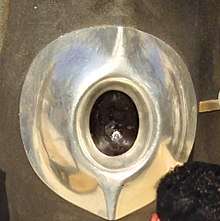
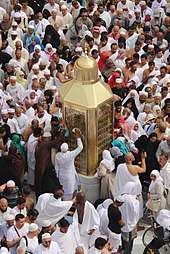 Maqam Ibrahim's crystal dome
Maqam Ibrahim's crystal dome- Mount Marwah within the mosque
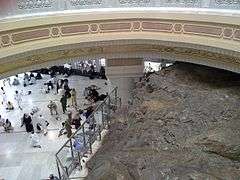 Mount Safa
Mount Safa- The well of Zamzam located beneath the floor (entrance now covered)
Controversies
There has been some controversy that the expansion projects of the mosque and Mecca itself are causing harm to early Islamic heritage. Many ancient buildings, some more than a thousand years old, have been demolished to make room for the expansion.[53] Some examples are:[54][55]
- Bayṫ Al-Mawlīd (Arabic: بَـيْـت الْـمَـوْلِـيْـد), the house where Muhammad was born, was demolished and rebuilt as a library.
- Dār Al-Arqam (Arabic: دَار الْأَرْقَـم), the Islamic school where Muhammad first taught, was flattened to lay marble tiles.
- The house of Abu Jahal has been demolished and replaced by public washrooms.
- A dome that served as a canopy over the Well of Zamzam was demolished.
- Some Ottoman porticos at the Mosque were demolished, and those remaining are under threat.
See also
Notes
- ↑ Abraham is believed to be from the ancient Iraqi city of Ur,[17] judging from passages in the Hebrew Bible.[18][19]
References
- ↑ "Location of Masjid al-Haram". Google Maps. Retrieved 24 September 2013.
- ↑ http://www.haramainsharifain.com/p/blog-page.html
- ↑ http://www.haramain.info
- ↑ Zeitlin, I. M. (2013-04-25). "3". The Historical Muhammad. John Wiley and Sons. ISBN 0745654886.
- ↑ Adamec, Ludwig (2009). Historical Dictionary of Islam, 2nd Edition. Lanham, Maryland: Scarecrow Press, Inc. p. 102. ISBN 9780810861619.
- ↑ Mohammad Taqi al-Modarresi (26 March 2016). The Laws of Islam (PDF) (in English). Enlight Press. ISBN 978-0994240989. Retrieved 22 December 2017.
- 1 2 "Saudi Arabia starts Mecca mosque expansion". reuters.com.
- ↑ Merriam-Webster's Geographical Dictionary. 2001. p. 479. ISBN 0 87779 546 0. Retrieved 2013-03-17.
- ↑ "Is Saudi Arabia Ready for Moderate Islam? - Latest Gulf News". www.fairobserver.com. Retrieved 2017-11-25.
- ↑ "As we prepare to fall back, here are seven great clocks of the world". Los Angeles Times. 2017-10-29. ISSN 0458-3035. Retrieved 2017-11-25.
- ↑ "Saudi Arabia Bulldozes Over Its Heritage" Check
|url=value (help). Time. Retrieved 2017-11-25. - ↑ Reid, Richard J. (12 January 2012). "The Islamic Frontier in Eastern Africa". A History of Modern Africa: 1800 to the Present. John Wiley and Sons. p. 106. ISBN 0470658983. Retrieved 15 March 2015.
- ↑ Palmer, A. L. (2016-05-26). Historical Dictionary of Architecture (2 ed.). Rowman & Littlefield. pp. 185–236. ISBN 1442263091.
- ↑ Quran 2:127 (Translated by Yusuf Ali)
- ↑ Quran 22:27
- ↑ Quran 21:57–58
- ↑ History of Islam by Professor Masudul Hasan
- ↑ Book of Genesis, Genesis 11:28, Genesis 11:31 and Genesis 15:7
- ↑ Book of Nehemiah, Nehemiah 9:7
- ↑ Mecca: From Before Genesis Until Now, M. Lings, pg. 39, Archetype
- ↑ Concise Encyclopedia of Islam, C. Glasse, Kaaba, Suhail Academy
- ↑ Ibn Ishaq, Muhammad (1955). Ibn Ishaq's Sirat Rasul Allah – The Life of Muhammad Translated by A. Guillaume. Oxford: Oxford University Press. pp. 88–9. ISBN 9780196360331.
- ↑ Karen Armstrong (2002). Islam: A Short History. p. 11. ISBN 0-8129-6618-X.
- ↑ Guidetti, Mattia (2016). In the Shadow of the Church: The Building of Mosques in Early Medieval Syria: The Building of Mosques in Early Medieval Syria. BRILL. p. 113. ISBN 9789004328839. Retrieved 17 September 2017.
- ↑ Petersen, Andrew (2002). Dictionary of Islamic Architecture. Routledge. ISBN 9781134613656. Retrieved 17 September 2017.
- ↑ Ali, Wijdan (1999). The Arab Contribution to Islamic Art: From the Seventh to the Fifteenth Centuries. American Univ in Cairo Press. ISBN 9789774244766. Retrieved 17 September 2017.
- ↑ James Wynbrandt (2010). A Brief History of Saudi Arabia. Infobase Publishing. p. 101. ISBN 978-0-8160-7876-9. Retrieved 12 June 2013.
- ↑ "Gates of Masjid al-Haram". Madain Project. Retrieved 17 March 2018.
- ↑ Ambitious new architecture plan for Al-Masjid Al-Haram
- ↑ https://www.telegraph.co.uk/travel/lists/the-worlds-most-expensive-buildings/masjid-al-haram-mecca-saudi-arabia/
- ↑ "Historic Masjid Al-Haram Extension Launched". onislam. 20 August 2011. Retrieved 17 November 2011.
- ↑ "Saudi King launches five Grand Mosque expansion projects".
- ↑ "Makkah crane crash report submitted". Al Arabiya. 14 September 2015. Retrieved 15 September 2015.
- ↑ "Daftar Nama Jemaah Rawat/Wafat Musibah Jatuhnya Crane Di Masjidil Haram 11 September 2015" [Names of Pilgrims Hospitalized/Dead in Calamity of Haram Crane Collapse September 11, 2015] (in Indonesian). Direktorat Jenderal Penyelenggaraan Haji dan Umrah - Kementerian Agama Republik Indonesia. 15 September 2015. Retrieved 16 September 2015.
- ↑ "King Salman to make findings of Makkah crane collapse probe public". Retrieved 2015-09-14.
- ↑ "Number of casualties of Turkish Haji candidates at the Kaaba accident reach 8…". Presidency of Religious Affairs. 13 September 2015. Archived from the original on 26 September 2015. Retrieved 15 September 2015.
- ↑ "Six Nigerians among victims of Saudi crane accident: official". Yahoo! News. AFP. 16 September 2015. Retrieved 16 September 2015.
- ↑ Halkon, Ruth; Webb, Sam (13 September 2015). "Two Brits dead and three injured in Mecca Grand Mosque crane tragedy that killed 107 people l". Mirror Online. Retrieved 16 September 2015.
- ↑ "Names of Former Imams 1345–1435 Ah". Retrieved 3 May 2017.
- ↑ WORTH, ROBERT F. (April 10, 2009). "A Black Imam Breaks Ground in Mecca". The New York Times. RIYADH.
- ↑ "Imām ibn Kathīr al-Makkī". Propheticguidance.co.uk. June 16, 2013. Retrieved April 13, 2016.
- ↑ Mohammed, Mamdouh N. (1996). Hajj to Umrah: From A to Z. Mamdouh Mohammed. ISBN 0-915957-54-X.
- ↑ General statistics of the Umrah season of 1436 A.H. until 24:00 hours, 28/09/1436 A.H. Total Number of the Mu`tamirs: 5,715,051 "General statistics of the Umrah season of 1436 A.H." The Ministry of Hajj, Kingdom of Saudi Arabia. Archived from the original on 13 August 2015.
- 1 2 Wensinck, A. J; Ka`ba. Encyclopaedia of Islam IV p. 317
- ↑ "In pictures: Hajj pilgrimage". BBC News. 7 December 2008. Retrieved 8 December 2008.
- ↑ "As Hajj begins, more changes and challenges in store". altmuslim. Archived from the original on 11 January 2012.
- ↑ Shaykh Safi-Ar-Rahman Al-Mubarkpuri (2002). Ar-Raheeq Al-Makhtum (The Sealed Nectar): Biography of the Prophet. Dar-As-Salam Publications. ISBN 1-59144-071-8.
- ↑ Elliott, Jeri (1992). Your Door to Arabia. Lower Hutt, N.Z.: R. Eberhardt. ISBN 0-473-01546-3.
- ↑ Mohamed, Mamdouh N. (1996). Hajj to Umrah: From A to Z. Amana Publications. ISBN 0-915957-54-X.
- 1 2 3 M.J. Kister, "Maḳām Ibrāhīm," p.105, The Encyclopaedia of Islam (new ed.), vol. VI (Mahk-Mid), eds. Bosworth et al., Brill: 1991, pp. 104-107.
- ↑ Quran 2:158 (Translated by Yusuf Ali)
- ↑ "Zamzam Studies and Research Centre". Saudi Geological Survey. Archived from the original on 5 February 2005. Retrieved 5 June 2005.
- ↑ Laessing, Ulf (18 November 2010). "Mecca goes Upmarket". Reuters. Retrieved 1 December 2010.
- ↑ Taylor, Jerome (24 September 2011). "Mecca for the rich: Islam's holiest site turning into Vegas". The Independent.
- ↑ Abou-Ragheb, Laith (12 July 2005). "Dr.Sami Angawi on Wahhabi Desecration of Makkah". Center for Islamic Pluralism. Retrieved 28 November 2010.
External links
| Wikimedia Commons has media related to Masjid al-Haram. |
- Complete compendium of Masjid al-Haram at Madain Project Archive
- Watch Live Al-Masjid al-Haram
- Official mobile application for indoor navigation system of the Grand Mosque
- Gallery of images of Mecca at 3dmekanlar.com
- Mecca, Kaaba, Al-Masjid 360 Degree Virtual Tour at 360tr.net
- Kaaba, Al-Masjid 360 Degree Virtual Tour at 360tr.com
- Recordings from Al-Masjid al-Haram at Haramain.info
- Al-Masjid al-Haram and al-Masjid al-Aqsa as the First and Second Mosques on Earth
